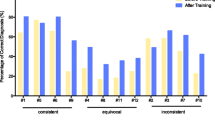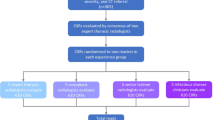Abstract
The objective of this study is to quantify the magnitude of intraobserver and interobserver agreement among physicians for the interpretation of pneumonia on pediatric chest radiographs. Chest radiographs that produced discordant interpretations between the emergency physician and the radiologist's final interpretation were identified for patients aged 1–4 years. From 24 radiographs, eight were randomly selected as study radiographs, and 16 were diversion films. Study participants included two pediatric radiologists, two senior emergency medicine physicians, and two junior fellowship-trained pediatric emergency medicine physicians. Each test included 12 radiographs: the eight study radiographs and four randomly interspersed diversion radiographs, and each radiograph was paired with a written clinical vignette. Testing was repeated on four occasions, separated by ≥2 weeks. The dependent variable was the interpretation of presence or absence of pneumonia; primary analysis done with Cohen's kappa (95% confidence intervals). Intraobserver agreement was good for pediatric radiologists (kappa = 0.87; 95% CI 0.60–0.99) for both but was lower for senior emergency physicians (mean kappa = 0.68; 95% CI 0.40–0.95) and junior pediatric emergency physicians (mean kappa = 0.62; 95% CI 0.35–0.98). Interobserver agreement was fair to moderate overall; between pediatric radiologists, kappa = 0.51 (0.39–0.64); between senior emergency physicians, kappa = 0.55 (0.41–69), and between junior pediatric emergency medicine physicians, kappa = 0.37 (0.25–0.51). Practicing emergency clinicians demonstrate considerable intraobserver and interobserver variability in the interpretation of pneumonia on pediatric chest radiographs.









Similar content being viewed by others
References
Bachur RMS, Harper MB R (2009) Radiographic pneumonia in young, highly febrile children with leukocytosis before and after universal conjugate pneumococcal vaccination. Pediatr Emerg Care 25:1–7
Centers for Disease Control and Prevention (CDC) (2009) Pneumonia hospitalizations among young children before and after introduction of pneumococcal conjugate vaccine—United States, 1997–2006. MMWR Morb Mortal Wkly Rep 58:1–4
Wardlaw T, Salama P, Johansson EW et al (2006) Pneumonia: the leading killer of Children. Lancet 368:1048–1050
Ranganathan SC, Sonnappa S (2009) Pneumonia and other respiratory infections. Pediatr Clin North Am 56:135–156
Green RSG, Fanelli JM SM et al (2009) Do published guidelines predict pneumonia in children presenting to an urban ED? Pediatr Emerg Care 17:240–243
Cleveland RH, Schluchter M, Wood BP et al (1997) Chest radiographic data acquisition and quality assurance in multicenter studies. Pediatr Radiol 27:880–887
Birkebaek NH, Hansen LK, Elle B (1999) Chest roentgenogram in the evaluation of heart defects in asymptomatic infants and children with a cardiac murmur: reproducibility and accuracy. Pediatrics 103:E15
Hendry SNJ, Eden OB M (1990) Inter-observer variation in interpretation of chest X-rays. Scott Med J 35:140–141
Al Aseri Z (2009) Accuracy of chest radiograph interpretation by emergency physicians. Emerg Radiol 16:111–114
Angoulvant F, Llor J, Alberti C et al (2008) Inter-observer variability in chest radiograph reading for diagnosing acute lung injury in children. Pediatr Pulmonol 43:987–991
Patel AB, Amin A, Sortey SZ et al (2007) Impact of training on observer variation in chest radiographs of children with severe pneumonia. Indian Pediatr 44:675–681
Bada C, Carreazo NY, Chalco et al (2007) Inter-observer agreement in interpreting chest X-rays on children with acute lower respiratory tract infections and concurrent wheezing. Sao Paulo Med J 125:150–154
Kramer MS, Roberts-Brauer R, Williams RL (1992) Bias and “overcall” in interpreting chest radiographs in young febrile children. Pediatrics 90:11–13
Hazir T, Nisar YB, Qazi SA et al (2006) Chest radiography in children aged 2–59 months diagnosed with non-severe pneumonia as defined by World Health Organization: descriptive multicentre study in Pakistan. BMJ 333:629
Cherian T, Mulholland EK, Carlin JB (2005) Standardized interpretation of pediatric chest radiographs for the diagnosis of pneumonia in epidemiological studies. Bull World Health Organ 83:353–359
Davies HD, Wang EE, Manson D et al (1996) Reliability of the chest radiograph in the diagnosis of lower respiratory infections in young children. Pediatr Infect Dis 15:600–604
Bloomfield FH, Teele RL, Voss M et al (1999) Inter- and intra-observer variability in assessment of atelectasis and consolidation in neonatal chest radiographs. Pediatr Radiol 29:459–462
Fonseca B, Chang RK, Senac M et al (2005) Chest radiography and the evaluation of the neonate for congenital heart disease. Pediatr Cardiol 26:367–372
Brennan P, Silman A (1992) Statistical methods for assessing observer variability in clinical measures. BMJ 304:1491–1494
Fleiss JL, Cuzick J (1997) Large sample variance of kappa in the case if different sets of raters. Psychol Bull 86:974–977
Gatt ME, Spectre G, Paltiel O et al (2003) Chest radiographs in the emergency department: is the radiologist really necessary? Postgrad Med J 79:214–217
Simon HK, Khan NS, Nordenburg DF (1996) Pediatric emergency physician interpretation of plain radiographs: is routine review by a radiologist necessary and cost-effective? Ann Emerg Med 27:295–298
Klein EJ, Koenig M, Diekema DS et al (1999) Discordant radiograph interpretation between emergency physicians and radiologists in a pediatric emergency department. Pediatr Emerg Care 15:245–248
Author information
Authors and Affiliations
Corresponding author
Rights and permissions
About this article
Cite this article
Johnson, J., Kline, J.A. Intraobserver and interobserver agreement of the interpretation of pediatric chest radiographs. Emerg Radiol 17, 285–290 (2010). https://doi.org/10.1007/s10140-009-0854-2
Received:
Accepted:
Published:
Issue Date:
DOI: https://doi.org/10.1007/s10140-009-0854-2




